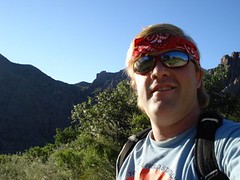BBNP Photo Report ~Scrub Desert Part One
Edward Abbey wrote of the desert, "it is a dangerous and terrible place. Enter at your own risk. Carry water. Avoid the noon day sun. Try to ignore the vultures. Pray frequently."
The majority of land in the Big Bend is scrub desert of the Chihuahuan variety. Most persons drive through this ecosystem and thank the good Lord for air-conditioning. But, I think, to really see it, one must walk through it. Spend some time. Get scratched and poked. Wonder at the emptiness.
 Agave lechiguilla or simply Lechiguilla is from what we could tell, the most common plant in the low desert. It is also called Spanish dagger, for obvious reason.
Agave lechiguilla or simply Lechiguilla is from what we could tell, the most common plant in the low desert. It is also called Spanish dagger, for obvious reason. I've now been able to hike around three of the four great North American deserts. I'm amazed at the great variety in the genus Opuntia. Here is Opuntia engelmannii or Golden-Spined Prickly Pear.
I've now been able to hike around three of the four great North American deserts. I'm amazed at the great variety in the genus Opuntia. Here is Opuntia engelmannii or Golden-Spined Prickly Pear. We ran into many insects that call the desert home. Here is a rather large katydid who has found some shelter in the spear-like leaves of a Torrey's Yucca (Yucca torreyii).
We ran into many insects that call the desert home. Here is a rather large katydid who has found some shelter in the spear-like leaves of a Torrey's Yucca (Yucca torreyii).

Ocotillo (Fouquieria splendens) is one of the neatest plants in the Chihuahuan desert. It looks like scrunched up pipe cleaners that someone has tried to straighten out. This shrub is drought deciduous, meaning it looses it's leaves when conditions become too severe. If the summer monsoons are strong enough though, it will leaf out again in late summer. Here is one with a Perigrine falcon (Falco perigrinus) sitting among it's thorns.







<< Home